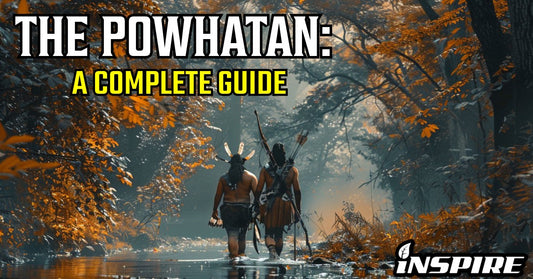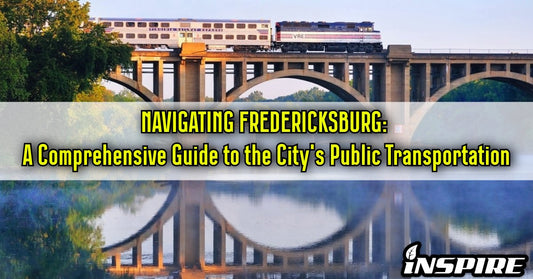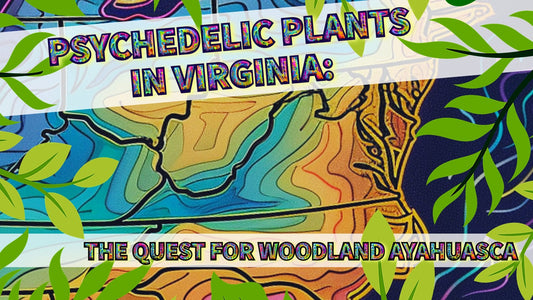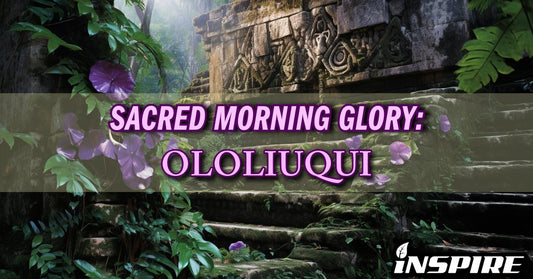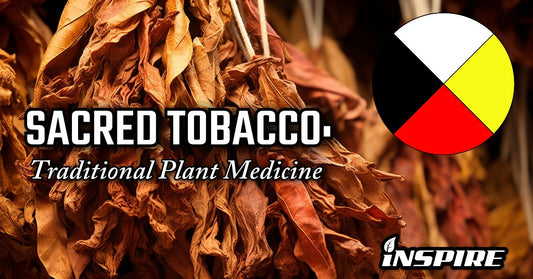WRITTEN BY: ZACH CHAMP
Connect with me on LinkedIn & Instagram!
![]()
As the morning sun rose brilliantly from the horizon, the low hanging clouds of fog that covered the country-side began to disappear. With their absence, one could finally see the vast never-ending range that was the Malheur-Curlew National Grasslands.
The range was quiet, while the air was cool and crisp, heavily perfumed with the scent of sage. The only sound was the occasional moos from the neighbors nearby- giant herds of cattle- who were still partly stirring from their slumber.
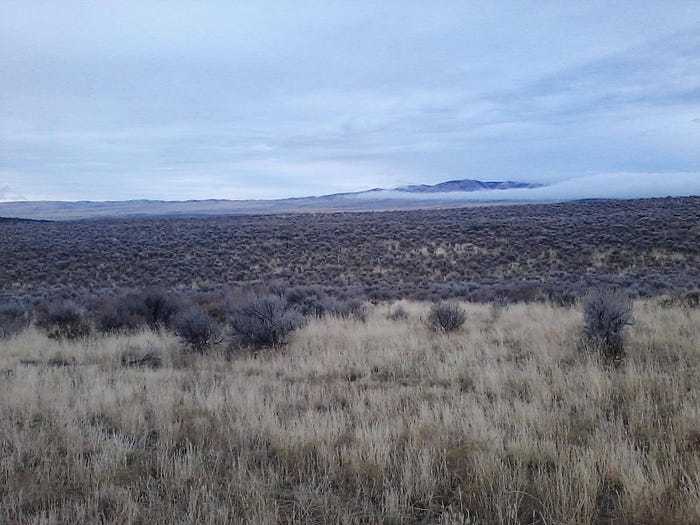
It was here in this forgotten wilderness that my crew was sent to assist the Bureau of Land Management (BLM) and U.S Forest Service for a 3-week long project during my 6-month service with the Idaho Conservation Corps.
We had received orders to go to the small farming community of Malad, Idaho located almost 270 miles east of Boise (the Capital City of Idaho) and 56 miles south of Pocatello (the next largest city around). Malad was a quaint country town, with one main street, a grocery, and a few essential stores. Its residents were either locals with ties to the area or farmworkers and their families.
Directly outside Malad was the Malheur-Curlew National Grassland which was located and administered next to its sister park the Caribou-Targhee National Forest (coincidentally our team had been deployed on a project here just previously before we arrived at the grasslands). The Malheur-Curlew National Grassland is close to 47,000 acres in total size and is managed by both the Bureau of Land Management and the US Forest Service.
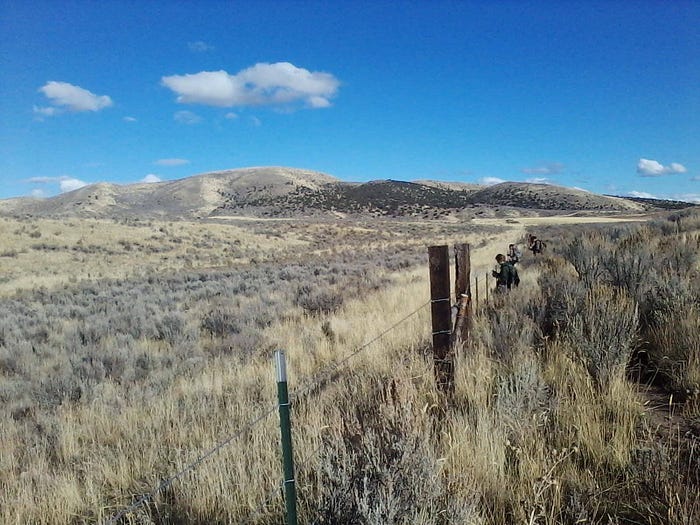
The grassland is intended for cattle grazing as well as recreational uses like hunting, fishing, and camping. It originally was created to preserve the unique character of the Sagebrush grasslands and to maintain the quality of the land for its continued use over generations. Malheur-Curlew National Grassland is the only National Grassland in the Western mountainous region of the United States.
So there we were, trudging along dozens of miles of barbed wire fence, carrying large canvas satchels that held hundreds if not thousands of small, bright fluorescent yellow reflective square tags. Every few meters we would stop walking, pull one of the tags out of our satchel, and using hog-nose pliers would clamp the tag to the barbed wire fence so that the reflective yellow tag would hang and float gently in the air.
Behind us, a steady stream of yellow tags remained behind as evidence of our endeavor.
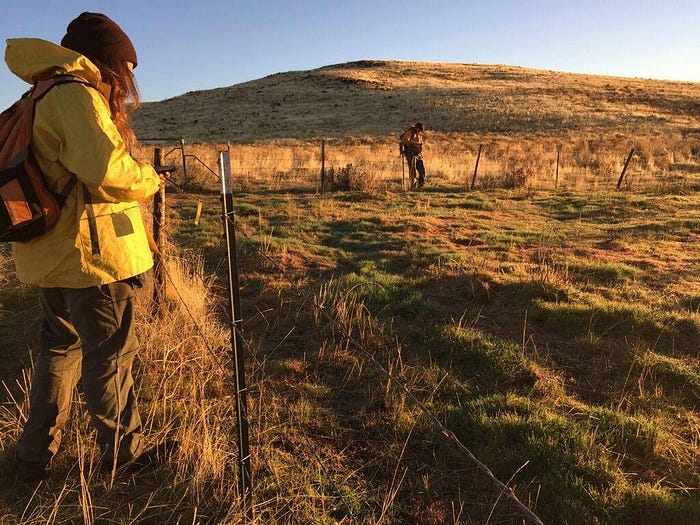
The work was monotonous and exhausting- the satchels holding all of the tags were heavy and we had to carry them swung over our shoulders like Santa Claus on Christmas Eve. There were miles and miles of barbed wire fence which had to be tagged. For almost three weeks we worked exclusively on this task…
Just what exactly were we doing out here amidst the Sagebrush and Cattle, and why were we tagging all the barbed wire fences?
The answer was the peculiar and endangered Sage Grouse. Out here in the vast and seemingly never-ending grasslands lived this special species of bird which was the focus of our conservation project.
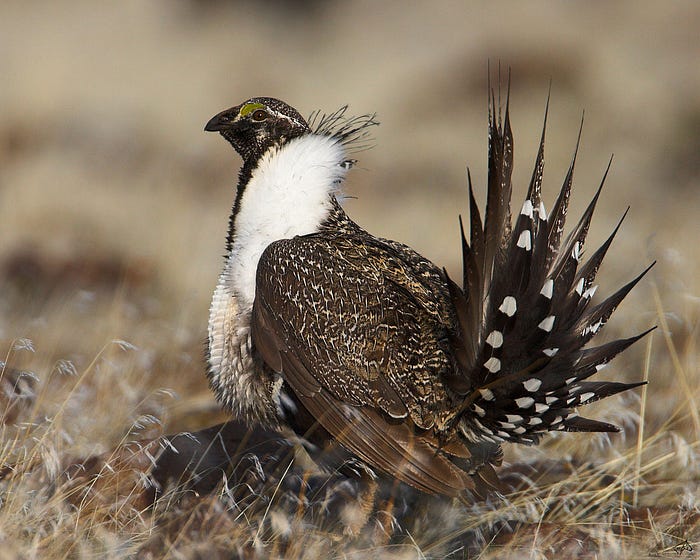
The Sage Grouse, also called the Sage Hen, is the largest North American bird of its kind. They are picky eaters, typically only eating sagebrush, herbaceous leaves from other local plant species such as Dandelion and Yarrow, and insects although this makes up only a fraction of their diet.
Over the past century, the sage-bush grasslands and deserts which the Sage Grouse thrives in have become radically altered. The impact of human activities such as cattle grazing, as well as wild-fires, and the arrival of invasive species all were threatening the home of this magnificent North American bird.
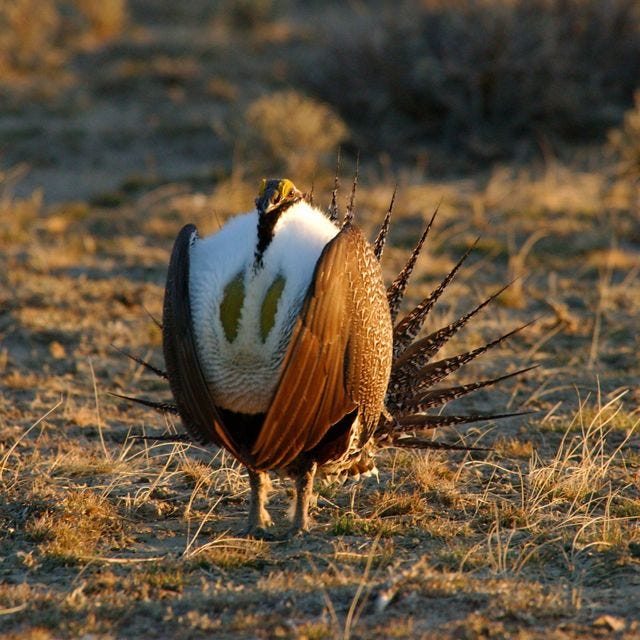
Without the proper course of action, the Sage Grouse as well as the rest of the Sagebrush ecosystem were at risk of being wiped out.
How does just one bird species affect the whole ecosystem? The answer lies within the complex food chain and food web that makes up the ecology of the Sagebrush grasslands!
In any ecosystem, there are always key species that most other wildlife depend upon in some shape or form. Sage Grouse is one example of such a species.
All plants and animals within an ecosystem play an important and interconnected role in stabilizing and maintaining the vitality of their environment. This is known as the Food Chain.
The Food Chain starts with the Sun, which provides energy and sustenance for all living things, but especially plants. Plants that grow from the Sun’s energy, primarily through the process of photosynthesis, will, in turn, get eaten by herbivores which are animals that get energy from eating vegetation.
Herbivores often are preyed upon by larger carnivores (or meat-eating animals) and both herbivores and carnivores often get consumed after dying by scavengers like Vultures and Beetles. Prey-predator relationships between living things comprise the flow of energy which we understand as the Food Chain or Food Web, i.e "the circle of life!"
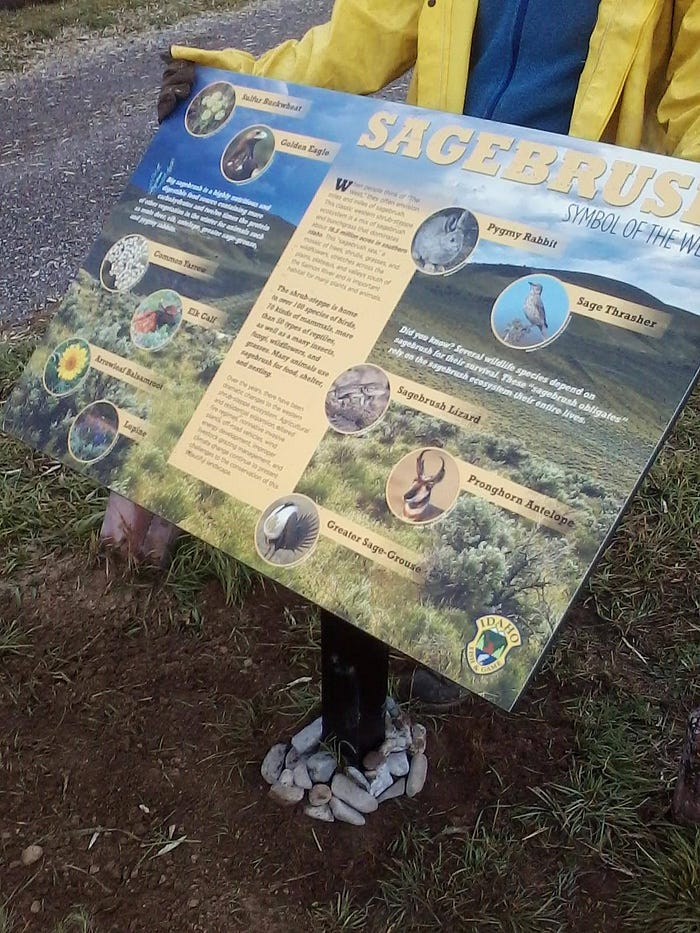
There are an estimated 350 species of wild plants and animals that thrive in the Sagebrush grasslands of North America. Nearly all of them, in some shape or form, rely on some type of interactions with the Sage Grouse to survive. Without the Sage Grouse, the whole food chain of the Sagebrush grassland biome would collapse!
As we hiked along trails laden with cow patties and sagebrush our crew would listen to the lectures and anecdotal stories provided to us by the US Wildlife Biologist who was our project manager. He would explain to us the complexities of the Sagebrush Grassland’s ecosystem- from the Sage Grouse and it’s unique mating rituals called the lek, to the jackrabbits we’d see occasionally sprinting and hopping around. The wildlife and plants that lived here were dependent on each other and the Sagebrush which was endemic to the land.
While we grabbed our tools from the U.S Forest Service government work truck, we’d notice the pump-action shotgun racked over the back seat.
Our project manager would smile and place a hand on the shotgun mentioning coyly “Coyotes and Catamounts”. The beautiful never-ending landscape was home to more than just birds and small mammals… at night larger animals stalked the Cattle and Grouse looking for opportunities to feed.
Normally predation from larger animals doesn’t impact the total population of Sage Grouse, but due to their diminished habitat, the Sage Grouse have had a hard time maintaining their reproduction levels. With less space for nesting and raising young, the Sage Grouse has become even more vulnerable to its typical predators such as the Coyote, Bobcat, American Badger, and Birds of Prey like Hawks, Falcons, and Eagles.
This problem has become so serious that in one recent study based in Nevada, an estimated 84% of nests observed were destroyed within 3 days of the start of the study. This is obviously not sustainable and a big concern for the future survival of the species.
For the past century and a half since the settling of the American West, locals would hunt Sage Grouse as a game bird. Sage Grouse is a traditional part of western and backcountry cuisine. Many conservationists initially thought that overhunting was also contributing to the declining numbers of Sage Grouse. However, studies have shown that hunting has had little impact on Sage-Grouse population numbers and that reduced population sizes are likely the results of other factors. Today, hunters and other recreational outdoorsmen are influential and key partners in Sage Grouse and Sagebrush Grassland conservation efforts.

Just what exactly is causing the Sage Grouse to disappear?
The Sage Grouse population has been reduced from an estimated 16 million birds from back in 1920 to about roughly 250,000 to 500,000 birds today. The main reason for this decline in the total population is primarily blamed on the loss of habitat due to residential development and energy infrastructure development in the grasslands.
Oil and Gas Pipelines, as well as turbines for large wind farms, are commonly built in prime Sage Grouse habitat, often crossing through the bird’s traditional breeding grounds known as a lek. Sage Grouse will avoid these areas once structures are built because they create perching spots for larger birds of prey and other predators.
Sage Grouse only mate and reproduce at these special spots, so once the lek has been destroyed or compromised, the birds have to migrate to another location which can sometimes be miles away.
Large numbers of Sage Grouse will rely upon the same lek to reproduce, so the loss of just one breeding ground can have severe consequences for the local ecosystem.
Agricultural and urban development are also contributing to the loss and fragmentation of Sage Grouse habitat.
Many people living out West near California, Oregon, Washington, and Idaho know that over the past decade or two there has been a boom in the number of people moving to these areas.
As the west is starting to develop, more people are moving out to the wilderness bringing with them new neighborhoods, strip malls, and parking lots which transform the once pristine landscape into an urban jungle ill-suited for survival of Sage Grouse and other western plant and animal species.
Ranching is an essential component of the Western American economy. Many families and small towns rely on local farms and ranches to make a living.
The impact of Cattle grazing on Western Landscapes is a double-edged sword and an issue of much controversy. One reason that so much of the land out West is owned and managed by the government through the Bureau of Land Management and U.S Forest Service is so that these agencies can lease the land to ranchers for use with cattle grazing.
The Federal government leases this land to the ranchers who get to use it, and in return, the government is in charge of maintaining the land so that natural resources are preserved for future generations and not exhausted or depleted permanently.
Nearly half of all existing Sage Grouse habitat is located on privately owned land, presenting a unique challenge to conservation efforts. In response to this, unique partnerships have been created like the Sage Grouse Initiative which works closely with private landowners and provides incentives from the Federal and State Governments for those who proactively work towards conserving American rangelands and wildlife.
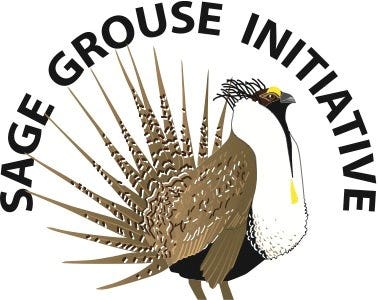
The Sage Grouse Initiative is part of the Natural Resources Conservation Service and was started in 2010.
It is a multi-agency partnership that brings together numerous Federal agencies, local and state governments, universities, private landowners, and regional businesses to address wildlife and habitat conservation efforts that impact these interests.
The NRCS has numerous landscape and wildlife conservation initiatives that it manages and oversees including currently active programs like the Great Lakes Restoration Initiative, the Mississippi River Basin Healthy Watersheds Initiative, the Longleaf Pine Forestry Initiative, and the Regional Monarch Butterfly Conservation Program.
The Sage Grouse Initiative provides a blueprint for landowners and other interests that includes practical solutions that promote wildlife habitat restoration and conservation. Landowners who adhere to program guidelines are rewarded with government incentives like tax writeoffs and land easements.
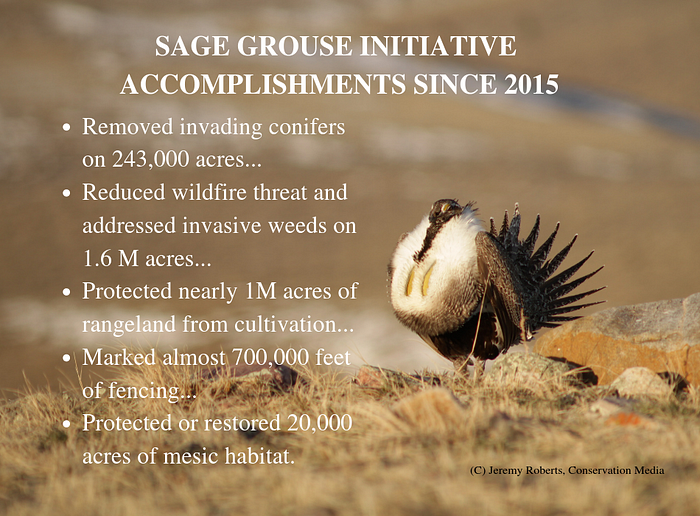
During the five years between 2010–2015, the Sage Grouse Initiative was able to successfully implement conservation efforts for more than 5.6 million acres of Sagebrush habitat. The program hopes to have conserved at least 8 million acres by 2018.
It is only by bringing together local communities, landowners, and government agencies to work cooperatively that we can be proactive in preserving our nation’s wildlife and lands for future generations.
The Sage Grouse needs the grasslands to survive, point-blank. If there is no Sagebrush, then there is no Sage Grouse… and if there is no Sage Grouse there can be no wild west as we know it!


